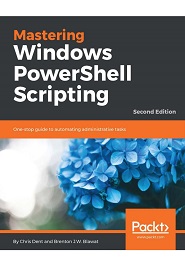
English | 2017 | ISBN: 978-1787126305 | 440 Pages | PDF, EPUB, AZW3 | 10 MB
One-stop guide to automating administrative tasks
Master the art of automating and managing your environment using PowerShell
PowerShell scripts offer a handy way to automate various chores. Working with these scripts effectively can be a difficult task.
This comprehensive guide starts from scratch and covers advanced-level topics to make you a PowerShell expert. The first module, PowerShell Fundamentals, begins with new features, installing PowerShell on Linux, working with parameters and objects, and also how you can work with .NET classes from within PowerShell.
In the next module, you’ll see how to efficiently manage large amounts of data and interact with other services using PowerShell. You’ll be able to make the most of PowerShell’s powerful automation feature, where you will have different methods to parse and manipulate data, regular expressions, and WMI.
After automation, you will enter the Extending PowerShell module, which covers topics such as asynchronous processing and, creating modules. The final step is to secure your PowerShell, so you will land in the last module, Securing and Debugging PowerShell, which covers PowerShell execution policies, error handling techniques, and testing.
By the end of the book, you will be an expert in using the PowerShell language.
What You Will Learn
- Optimize code through the use of functions, switches, and looping structures
- Install PowerShell on your Linux system
- Utilize variables, hashes, and arrays to store data
- Work with Objects and Operators to test and manipulate data
- Parse and manipulate different data types
- Write .NET classes with ease within the PowerShell
- Create and implement regular expressions in PowerShell scripts
- Deploy applications and code with PowerShell’s Package management modules
- Leverage session-based remote management
- Manage files, folders, and registries through the use of PowerShell
Resolve the captcha to access the links!